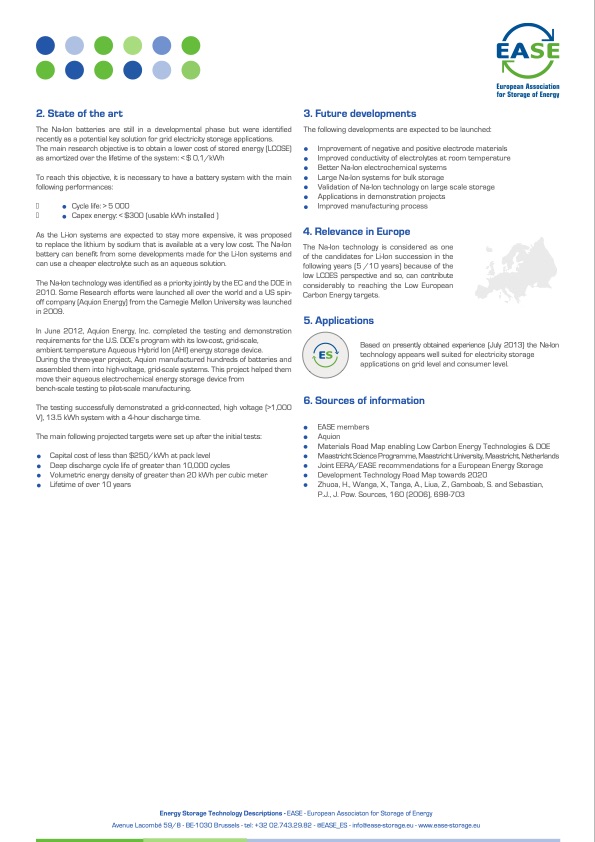
PDF Publication Title:
Text from PDF Page: 002
2. State of the art The Na-Ion batteries are still in a developmental phase but were identified recently as a potential key solution for grid electricity storage applications. The main research objective is to obtain a lower cost of stored energy (LCOSE) as amortized over the lifetime of the system: < $ 0,1/kWh To reach this objective, it is necessary to have a battery system with the main following performances: Cycle life: > 5 000 Capex energy: < $300 (usable kWh installed ) As the Li-ion systems are expected to stay more expensive, it was proposed to replace the lithium by sodium that is available at a very low cost. The Na-Ion battery can benefit from some developments made for the Li-Ion systems and can use a cheaper electrolyte such as an aqueous solution. The Na-Ion technology was identified as a priority jointly by the EC and the DOE in 2010. Some Research efforts were launched all over the world and a US spin- off company (Aquion Energy) from the Carnegie Mellon University was launched in 2009. In June 2012, Aquion Energy, Inc. completed the testing and demonstration requirements for the U.S. DOE’s program with its low-cost, grid-scale, ambient temperature Aqueous Hybrid Ion (AHI) energy storage device. During the three-year project, Aquion manufactured hundreds of batteries and assembled them into high-voltage, grid-scale systems. This project helped them move their aqueous electrochemical energy storage device from bench-scale testing to pilot-scale manufacturing. The testing successfully demonstrated a grid-connected, high voltage (>1,000 V), 13.5 kWh system with a 4-hour discharge time. The main following projected targets were set up after the initial tests: Capital cost of less than $250/kWh at pack level Deep discharge cycle life of greater than 10,000 cycles Volumetric energy density of greater than 20 kWh per cubic meter Lifetime of over 10 years 3. Future developments The following developments are expected to be launched: Improvement of negative and positive electrode materials Improved conductivity of electrolytes at room temperature Better Na-Ion electrochemical systems Large Na-Ion systems for bulk storage Validation of Na-Ion technology on large scale storage Applications in demonstration projects Improved manufacturing process 4. Relevance in Europe The Na-Ion technology is considered as one of the candidates for Li-Ion succession in the following years (5 /10 years) because of the low LCOES perspective and so, can contribute considerably to reaching the Low European Carbon Energy targets. 5. Applications Based on presently obtained experience (July 2013) the Na-Ion technology appears well suited for electricity storage applications on grid level and consumer level. 6. Sources of information EASE members Aquion Materials Road Map enabling Low Carbon Energy Technologies & DOE Maastricht Science Programme, Maastricht University, Maastricht, Netherlands Joint EERA/EASE recommendations for a European Energy Storage Development Technology Road Map towards 2020 Zhuoa, H., Wanga, X., Tanga, A., Liua, Z., Gamboab, S. and Sebastian, P.J., J. Pow. Sources, 160 (2006), 698-703 Energy Storage Technology Descriptions - EASE - European Associaton for Storage of Energy Avenue Lacombé 59/8 - BE-1030 Brussels - tel: +32 02.743.29.82 - @EASE_ES - info@ease-storage.eu - www.ease-storage.euPDF Image | Sodium-ion Battery Energy Storage

PDF Search Title:
Sodium-ion Battery Energy StorageOriginal File Name Searched:
EASE_TD_Electrochemical_NaIon.pdfDIY PDF Search: Google It | Yahoo | Bing
Salgenx Redox Flow Battery Technology: Salt water flow battery technology with low cost and great energy density that can be used for power storage and thermal storage. Let us de-risk your production using our license. Our aqueous flow battery is less cost than Tesla Megapack and available faster. Redox flow battery. No membrane needed like with Vanadium, or Bromine. Salgenx flow battery
| CONTACT TEL: 608-238-6001 Email: greg@salgenx.com | RSS | AMP |